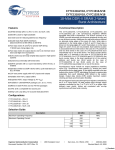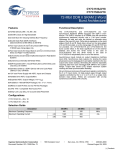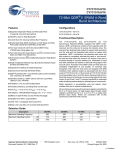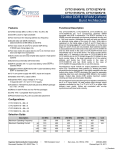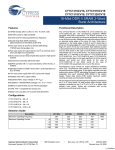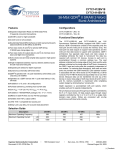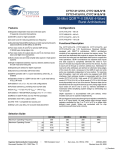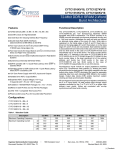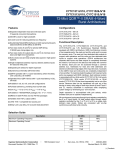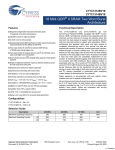Download Cypress Semiconductor CY7C1318JV18 Datasheet
Transcript
CY7C1318JV18 CY7C1320JV18 18 Mbit DDR II SRAM Two Word Burst Architecture Features Functional Description ■ 18 Mbit Density (1M x 18, 512K x 36) ■ 300 MHz Clock for High Bandwidth ■ Two word Burst for reducing Address Bus Frequency ■ Double Data Rate (DDR) Interfaces (data transferred at 600 MHz) at 300 MHz ■ Two Input Clocks (K and K) for Precise DDR Timing ❐ SRAM uses rising edges only ■ Two Input Clocks for Output Data (C and C) to Minimize Clock Skew and Flight Time mismatches ■ Echo Clocks (CQ and CQ) simplify Data Capture in High Speed systems The CY7C1318JV18, and CY7C1320JV18 are 1.8V Synchronous Pipelined SRAMs equipped with DDR II architecture. The DDR II consists of an SRAM core with advanced synchronous peripheral circuitry and a one bit burst counter. Addresses for read and write are latched on alternate rising edges of the input (K) clock. Write data is registered on the rising edges of both K and K. Read data is driven on the rising edges of C and C if provided, or on the rising edge of K and K if C/C are not provided. For CY7C1318JV18 and CY7C1320JV18, the burst counter takes in the least significant bit of the external address and bursts two 18 bit words (in the case of CY7C1318JV18) of two 36 bit words (in the case of CY7C1320JV18) sequentially into or out of the device. ■ Synchronous Internally self timed Writes ■ DDR II Operates with 1.5 Cycle Read Latency when the DLL is enabled ■ Operates similar to a DDR I Device with 1 Cycle Read Latency in DLL Off Mode ■ 1.8V Core Power Supply with HSTL Inputs and Outputs ■ Variable drive HSTL Output Buffers ■ Expanded HSTL Output Voltage (1.4V–VDD) ■ Available in 165-ball FBGA Package (13 x 15 x 1.4 mm) ■ Offered in both Pb-free and non Pb-free packages ■ JTAG 1149.1 Compatible Test Access Port ■ Delay Lock Loop (DLL) for Accurate Data Placement Asynchronous inputs include an output impedance matching input (ZQ). Synchronous data outputs (Q, sharing the same physical pins as the data inputs, D) are tightly matched to the two output echo clocks CQ/CQ, eliminating the need to capture data separately from each individual DDR SRAM in the system design. Output data clocks (C/C) enable maximum system clocking and data synchronization flexibility. All synchronous inputs pass through input registers controlled by the K or K input clocks. All data outputs pass through output registers controlled by the C or C (or K or K in a single clock domain) input clocks. Writes are conducted with on-chip synchronous self timed write circuitry. Configurations CY7C1318JV18 – 1M x 18 CY7C1320JV18 – 512K x 36 Selection Guide Description Maximum Operating Frequency Maximum Operating Current Cypress Semiconductor Corporation Document Number: 001-15271 Rev. *E • 300 MHz 250 MHz Unit 300 250 MHz x18 655 600 mA x36 730 635 198 Champion Court • San Jose, CA 95134-1709 • 408-943-2600 Revised August 25, 2009 [+] Feedback CY7C1318JV18 CY7C1320JV18 Logic Block Diagram (CY7C1318JV18) A(19:1) LD Address Register K CLK Gen. K Write Add. Decode 19 DOFF Write Reg Write Reg 512K x 18 Array 20 512K x 18 Array A(19:0) Read Add. Decode Burst Logic A0 18 Output Logic Control R/W C Read Data Reg. C CQ 36 VREF 18 Control Logic R/W Reg. 18 Reg. 18 CQ 18 18 BWS[1:0] Reg. DQ[17:0] Logic Block Diagram (CY7C1318JV18) A(18:1) LD Address Register K K CLK Gen. DOFF Write Reg Write Reg 36 Output Logic Control R/W C Read Data Reg. C CQ 72 VREF R/W Write Add. Decode 18 256K x 36 Array 19 256K x 36 Array A(18:0) Read Add. Decode Burst Logic A0 36 Control Logic BWS[3:0] Document Number: 001-15271 Rev. *E 36 Reg. Reg. 36 Reg. 36 CQ 36 DQ[35:0] Page 2 of 24 [+] Feedback CY7C1318JV18 CY7C1320JV18 Pin Configuration The pin configuration for CY7C1318JV18, and CY7C1320JV18 follows. [1] 165-Ball FBGA (13 x 15 x 1.4 mm) Pinout CY7C1318JV18 (1M x 18) 1 2 3 4 5 6 7 8 9 10 11 A CQ NC/72M A R/W BWS1 K NC/144M LD A NC/36M CQ B NC DQ9 NC A NC/288M K BWS0 A NC NC DQ8 C NC NC NC VSS A A0 A VSS NC DQ7 NC D NC NC DQ10 VSS VSS VSS VSS VSS NC NC NC E NC NC DQ11 VDDQ VSS VSS VSS VDDQ NC NC DQ6 F NC DQ12 NC VDDQ VDD VSS VDD VDDQ NC NC DQ5 G NC NC DQ13 VDDQ VDD VSS VDD VDDQ NC NC NC H DOFF VREF VDDQ VDDQ VDD VSS VDD VDDQ VDDQ VREF ZQ J NC NC NC VDDQ VDD VSS VDD VDDQ NC DQ4 NC K NC NC DQ14 VDDQ VDD VSS VDD VDDQ NC NC DQ3 L NC DQ15 NC VDDQ VSS VSS VSS VDDQ NC NC DQ2 M NC NC NC VSS VSS VSS VSS VSS NC DQ1 NC N NC NC DQ16 VSS A A A VSS NC NC NC P NC NC DQ17 A A C A A NC NC DQ0 R TDO TCK A A A C A A A TMS TDI CY7C1320JV18 (512K x 36) 1 2 4 5 6 7 8 9 10 11 R/W BWS2 K BWS1 LD A NC/72M CQ DQ18 A BWS3 K BWS0 A NC NC DQ8 DQ28 VSS A A0 A VSS NC DQ17 DQ7 DQ19 VSS VSS VSS VSS VSS NC NC DQ16 DQ20 VDDQ VSS VSS VSS VDDQ NC DQ15 DQ6 DQ21 VDDQ VDD VSS VDD VDDQ NC NC DQ5 DQ22 VDDQ VDD VSS VDD VDDQ NC NC DQ14 VDDQ VDDQ VDD VSS VDD VDDQ VDDQ VREF ZQ DQ32 VDDQ VDD VSS VDD VDDQ NC DQ13 DQ4 DQ23 VDDQ VDD VSS VDD VDDQ NC DQ12 DQ3 DQ33 DQ24 VDDQ VSS VSS VSS VDDQ NC NC DQ2 A CQ B NC DQ27 C NC NC D NC DQ29 E NC NC F NC DQ30 G NC DQ31 H DOFF VREF J NC NC K NC NC L NC 3 NC/144M NC/36M M NC NC DQ34 VSS VSS VSS VSS VSS NC DQ11 DQ1 N NC DQ35 DQ25 VSS A A A VSS NC NC DQ10 P NC NC DQ26 A A C A A NC DQ9 DQ0 R TDO TCK A A A C A A A TMS TDI Note 1. NC/36M, NC/72M, NC/144M, and NC/288M are not connected to the die and can be tied to any voltage level. Document Number: 001-15271 Rev. *E Page 3 of 24 [+] Feedback CY7C1318JV18 CY7C1320JV18 Pin Definitions Pin Name IO Pin Description DQ[x:0] Input OutputSynchronous Data Input Output Signals. Sampled on the rising edge of K and K clocks during valid write operations. These pins drive out the requested data during a read operation. Valid data is driven out on the rising edge of both the C and C clocks during read operations or K and K when in single clock mode. When read access is deselected, Q[x:0] are automatically tri-stated. CY7C1318JV18 − DQ[17:0] CY7C1320JV18 − DQ[35:0] LD InputSynchronous Synchronous Load. This input is brought LOW when a bus cycle sequence is defined. This definition includes address and read/write direction. All transactions operate on a burst of 2 data. BWS0, BWS1, BWS2, BWS3 InputSynchronous Byte Write Select 0, 1, 2, and 3 − Active LOW. Sampled on the rising edge of the K and K clocks during write operations. Used to select which byte is written into the device during the current portion of the Write operations. Bytes not written remain unaltered. CY7C1318JV18 − BWS0 controls D[8:0] and BWS1 controls D[17:9]. CY7C1320JV18 − BWS0 controls D[8:0], BWS1 controls D[17:9], BWS2 controls D[26:18] and BWS3 controls D[35:27]. All the Byte Write Selects are sampled on the same edge as the data. Deselecting a Byte Write Select ignores the corresponding byte of data and it is not written into the device. A, A0 InputSynchronous Address Inputs. These address inputs are multiplexed for both read and write operations. Internally, the device is organized as 1M x 18 (2 arrays each of 512K x 18) for CY7C1318JV18, and 512K x 36 (2 arrays each of 256K x 36) for CY7C1320JV18. CY7C1318JV18 – A0 is the input to the burst counter. These are incremented internally in a linear fashion. 20 address inputs are needed to access the entire memory array. CY7C1320JV18 – A0 is the input to the burst counter. These are incremented internally in a linear fashion. 19 address inputs are needed to access the entire memory array. All the address inputs are ignored when the appropriate port is deselected. R/W InputSynchronous Synchronous Read/Write Input. When LD is LOW, this input designates the access type (read when R/W is HIGH, write when R/W is LOW) for the loaded address. R/W must meet the setup and hold times around the edge of K. C Input Clock Positive Input Clock for Output Data. C is used in conjunction with C to clock out the read data from the device. C and C are used together to deskew the flight times of various devices on the board back to the controller. See Application Example on page 7 for more information. C Input Clock Negative Input Clock for Output Data. C is used in conjunction with C to clock out the read data from the device. C and C are used together to deskew the flight times of various devices on the board back to the controller. See Application Example on page 7 for more information. K Input Clock Positive Input Clock Input. The rising edge of K is used to capture synchronous inputs to the device and to drive out data through Q[x:0] when in single clock mode. All accesses are initiated on the rising edge of K. K Input Clock Negative Input Clock Input. K is used to capture synchronous data being presented to the device and to drive out data through Q[x:0] when in single clock mode. CQ Output Clock CQ is Referenced With Respect to C. This is a free running clock and is synchronized to the input clock for output data (C) of the DDR II. In single clock mode, CQ is generated with respect to K. The timing for the echo clocks is shown in Switching Characteristics on page 21. CQ Output Clock CQ is Referenced With Respect to C. This is a free running clock and is synchronized to the input clock for output data (C) of the DDR II. In single clock mode, CQ is generated with respect to K. The timing for the echo clocks is shown in Switching Characteristics on page 21. ZQ Input Output Impedance Matching Input. This input is used to tune the device outputs to the system data bus impedance. CQ, CQ, and Q[x:0] output impedance are set to 0.2 x RQ, where RQ is a resistor connected between ZQ and ground. Alternatively, this pin is connected directly to VDDQ, which enables the minimum impedance mode. This pin cannot be connected directly to GND or left unconnected. Document Number: 001-15271 Rev. *E Page 4 of 24 [+] Feedback CY7C1318JV18 CY7C1320JV18 Pin Definitions Pin Name (continued) IO Pin Description DOFF Input DLL Turn Off − Active LOW. Connecting this pin to ground turns off the DLL inside the device. The timing in the DLL turned off operation is different from that listed in this data sheet. For normal operation, this pin is connected to a pull up through a 10 Kohm or less pull up resistor. The device behaves in DDR I mode when the DLL is turned off. In this mode, the device is operated at a frequency of up to 167 MHz with DDR I timing. TDO Output TDO for JTAG. TCK Input TCK Pin for JTAG. TDI Input TDI Pin for JTAG. TMS Input TMS Pin for JTAG. NC N/A Not Connected to the Die. Can be tied to any voltage level. NC/36M N/A Not Connected to the Die. Can be tied to any voltage level. NC/72M N/A Not Connected to the Die. Can be tied to any voltage level. NC/144M N/A Not Connected to the Die. Can be tied to any voltage level. NC/288M N/A Not Connected to the Die. Can be tied to any voltage level. VREF InputReference Reference Voltage Input. Static input used to set the reference level for HSTL inputs, outputs, and AC measurement points. VDD Power Supply Power Supply Inputs to the Core of the Device. VSS Ground VDDQ Power Supply Power Supply Inputs for the Outputs of the Device. Ground for the Device. Document Number: 001-15271 Rev. *E Page 5 of 24 [+] Feedback CY7C1318JV18 CY7C1320JV18 Functional Overview The CY7C1318JV18, and CY7C1320JV18 are synchronous pipelined Burst SRAMs equipped with a DDR interface, which operates with a read latency of one and half cycles when DOFF pin is tied HIGH. When DOFF pin is set LOW or connected to VSS the device behaves in DDR I mode with a read latency of one clock cycle. Accesses are initiated on the rising edge of the positive input clock (K). All synchronous input timing is referenced from the rising edge of the input clocks (K and K) and all output timing is referenced to the rising edge of the output clocks (C/C, or K/K when in single clock mode). All synchronous data inputs (D[x:0]) pass through input registers controlled by the rising edge of the input clocks (K and K). All synchronous data outputs (Q[x:0]) pass through output registers controlled by the rising edge of the output clocks (C/C, or K/K when in single-clock mode). All synchronous control (R/W, LD, BWS[0:X]) inputs pass through input registers controlled by the rising edge of the input clock (K). CY7C1318JV18 is described in the following sections. The same basic descriptions apply to CY7C1320JV18. Read Operations The CY7C1318JV18 is organized internally as two arrays of 512K x 18. Accesses are completed in a burst of two sequential 18 bit data words. Read operations are initiated by asserting R/W HIGH and LD LOW at the rising edge of the positive input clock (K). The address presented to address inputs is stored in the read address register and the least significant bit of the address is presented to the burst counter. The burst counter increments the address in a linear fashion. Following the next K clock rise, the corresponding 18 bit word of data from this address location is driven onto Q[17:0], using C as the output timing reference. On the subsequent rising edge of C the next 18 bit data word from the address location generated by the burst counter is driven onto Q[17:0]. The requested data is valid 0.45 ns from the rising edge of the output clock (C or C, or K and K when in single clock mode, 200 MHz and 250 MHz device). To maintain the internal logic, enable each read access to complete. Read accesses are initiated on every rising edge of the positive input clock (K). The CY7C1318JV18 first completes the pending read transactions, when read access is deselected. Synchronous internal circuitry automatically tri-states the output following the next rising edge of the positive output clock (C). This enables a seamless transition between devices without the insertion of wait states in a depth expanded memory. Write Operations Write operations are initiated by asserting R/W LOW and LD LOW at the rising edge of the positive input clock (K). The address presented to address inputs is stored in the write address register and the least significant bit of the address is presented to the burst counter. The burst counter increments the address in a linear fashion. On the following K clock rise the data presented to D[17:0] is latched and stored into the 18 bit write data register, provided BWS[1:0] are both asserted active. On the subsequent rising edge of the negative input clock (K) the information presented to D[17:0] is also stored into the write data register, provided BWS[1:0] are both asserted active. The 36 bits Document Number: 001-15271 Rev. *E of data are then written into the memory array at the specified location. Write accesses are initiated on every rising edge of the positive input clock (K). This pipelines the data flow such that 18 bits of data can be transferred into the device on every rising edge of the input clocks (K and K). When Write access is deselected, the device ignores all inputs after the pending write operations are completed. Byte Write Operations Byte write operations are supported by the CY7C1318JV18. A write operation is initiated as described in the Write Operations section. The bytes that are written are determined by BWS0 and BWS1, which are sampled with each set of 18 bit data words. Asserting the byte write select input during the data portion of a write latches the data being presented and writes it into the device. Deasserting the Byte Write Select input during the data portion of a write enables the data stored in the device for that byte to remain unaltered. This feature is used to simplify read, modify, and write operations to a byte write operation. Single Clock Mode The CY7C1318JV18 is used with a single clock that controls both the input and output registers. In this mode the device recognizes only a single pair of input clocks (K and K) that control both the input and output registers. This operation is identical to the operation if the device had zero skew between the K/K and C/C clocks. All timing parameters remain the same in this mode. To use this mode of operation, tie C and C HIGH at power on. This function is a strap option and not alterable during device operation. DDR Operation The CY7C1318JV18 enables high performance operation through high clock frequencies (achieved through pipelining) and double data rate mode of operation. The CY7C1318JV18 requires a single No Operation (NOP) cycle when transitioning from a read to a write cycle. At higher frequencies, some applications require a second NOP cycle to avoid contention. If a read occurs after a write cycle, address and data for the write are stored in registers. Store the write information because the SRAM cannot perform the last word write to the array without conflicting with the read. The data stays in this register until the next write cycle occurs. On the first write cycle after the read(s), the stored data from the earlier write is written into the SRAM array. This is called a posted write. If a read is performed on the same address on which a write is performed in the previous cycle, the SRAM reads out the most current data. The SRAM does this by bypassing the memory array and reading the data from the registers. Depth Expansion Depth expansion requires replicating the LD control signal for each bank. All other control signals are common between banks as appropriate. Programmable Impedance Connect an external resistor, RQ, between the ZQ pin on the SRAM and VSS to enable the SRAM to adjust its output driver impedance. The value of RQ is five times the value of the intended line impedance driven by the SRAM. The allowable Page 6 of 24 [+] Feedback CY7C1318JV18 CY7C1320JV18 range of RQ to guarantee impedance matching with a tolerance of ±15 percent is between 175Ω and 350Ω, with VDDQ = 1.5V. The output impedance is adjusted every 1024 cycles at power up to account for drifts in supply voltage and temperature. Echo Clocks Echo clocks are provided on the DDR II to simplify data capture on high speed systems. Two echo clocks are generated by the DDR II. CQ is referenced with respect to C and CQ is referenced with respect to C. These are free running clocks and are synchronized to the output clock of the DDR II. In the single clock mode, CQ is generated with respect to K and CQ is generated with respect to K. The timing for the echo clocks is shown in Switching Characteristics on page 21. DLL These chips use a Delay Lock Loop (DLL) that is designed to function between 120 MHz and the specified maximum clock frequency. During power up, when the DOFF is tied HIGH, the DLL is locked after 1024 cycles of stable clock. The DLL is also reset by slowing or stopping the input clocks K and K for a minimum of 30 ns. However, it is not necessary to reset the DLL to lock to the desired frequency. The DLL automatically locks 1024 clock cycles after a stable clock is presented. Disable the DLL by applying ground to the DOFF pin. When the DLL is turned off, the device behaves in DDR I mode (with one cycle latency and a longer access time). For information refer to the application note DLL Considerations in QDRII™/DDRII. Application Example Figure 1 shows two DDR II used in an application. Figure 1. Application Example SRAM#1 DQ A DQ Addresses Cycle Start# R/W# Return CLK Source CLK Return CLK# Source CLK# Echo Clock1/Echo Clock#1 Echo Clock2/Echo Clock#2 BUS MASTER (CPU or ASIC) ZQ CQ/CQ# LD# R/W# C C# K K# R = 250ohms SRAM#2 DQ A ZQ CQ/CQ# LD# R/W# C C# K K# R = 250ohms Vterm = 0.75V R = 50ohms Vterm = 0.75V Document Number: 001-15271 Rev. *E Page 7 of 24 [+] Feedback CY7C1318JV18 CY7C1320JV18 Truth Table The truth table for the CY7C1318JV18, and CY7C1320JV18 follows. [2, 3, 4, 5, 6, 7] Operation K LD R/W Write Cycle: Load address; wait one cycle; input write data on consecutive K and K rising edges. L-H L L D(A1) at K(t + 1) ↑ D(A2) at K(t + 1) ↑ Read Cycle: Load address; wait one and a half cycle; read data on consecutive C and C rising edges. L-H L H Q(A1) at C(t + 1)↑ Q(A2) at C(t + 2) ↑ NOP: No Operation L-H H X High Z High Z Stopped X X Previous State Previous State Standby: Clock Stopped DQ DQ Burst Address Table (CY7C1318JV18, CY7C1320JV18) First Address (External) Second Address (Internal) X..X0 X..X1 X..X1 X..X0 Write Cycle Descriptions The write cycle description table for CY7C1318JV18 follows. [2, 8] BWS0 BWS1 K K L L L–H – L L – L H L–H L H – H L L–H H L – H H L–H H H – Comments During the data portion of a write sequence : Both bytes (D[17:0]) are written into the device. L-H During the data portion of a write sequence : Both bytes (D[17:0]) are written into the device. – During the data portion of a write sequence : Only the lower byte (D[8:0]) is written into the device, D[17:9] remains unaltered. L–H During the data portion of a write sequence : Only the lower byte (D[8:0]) is written into the device, D[17:9] remains unaltered. – During the data portion of a write sequence : Only the upper byte (D[17:9]) is written into the device, D[8:0] remains unaltered. L–H During the data portion of a write sequence : Only the upper byte (D[17:9]) is written into the device, D[8:0] remains unaltered. – No data is written into the devices during this portion of a write operation. L–H No data is written into the devices during this portion of a write operation. Notes 2. X = “Don’t Care,” H = Logic HIGH, L = Logic LOW, ↑ represents rising edge. 3. Device powers up deselected with the outputs in a tri-state condition. 4. On CY7C1318JV18 and CY7C1320JV18, “A1” represents address location latched by the devices when transaction was initiated and “A2” represents the addresses sequence in the burst. 5. “t” represents the cycle at which a read/write operation is started. t + 1 and t + 2 are the first and second clock cycles succeeding the “t” clock cycle. 6. Data inputs are registered at K and K rising edges. Data outputs are delivered on C and C rising edges, except when in single clock mode. 7. It is recommended that K = K and C = C = HIGH when clock is stopped. This is not essential, but permits most rapid restart by overcoming transmission line charging symmetrically. 8. Is based on a write cycle that was initiated in accordance with the Write Cycle Descriptions table. BWS0, BWS1, BWS2, and BWS3 can be altered on different portions of a write cycle, as long as the setup and hold requirements are achieved. Document Number: 001-15271 Rev. *E Page 8 of 24 [+] Feedback CY7C1318JV18 CY7C1320JV18 Write Cycle Descriptions The write cycle description table for CY7C1320JV18 follows. [2, 8] BWS0 BWS1 BWS2 BWS3 K K Comments L L L L L–H – During the data portion of a write sequence, all four bytes (D[35:0]) are written into the device. L L L L – L H H H L–H L H H H – H L H H L–H H L H H – H H L H L–H H H L H – H H H L L–H H H H L – H H H H L–H H H H H – Document Number: 001-15271 Rev. *E L–H During the data portion of a write sequence, all four bytes (D[35:0]) are written into the device. – During the data portion of a write sequence, only the lower byte (D[8:0]) is written into the device. D[35:9] remains unaltered. L–H During the data portion of a write sequence, only the lower byte (D[8:0]) is written into the device. D[35:9] remains unaltered. – During the data portion of a write sequence, only the byte (D[17:9]) is written into the device. D[8:0] and D[35:18] remains unaltered. L–H During the data portion of a write sequence, only the byte (D[17:9]) is written into the device. D[8:0] and D[35:18] remains unaltered. – During the data portion of a write sequence, only the byte (D[26:18]) is written into the device. D[17:0] and D[35:27] remains unaltered. L–H During the data portion of a write sequence, only the byte (D[26:18]) is written into the device. D[17:0] and D[35:27] remains unaltered. – During the data portion of a write sequence, only the byte (D[35:27]) is written into the device. D[26:0] remains unaltered. L–H During the data portion of a write sequence, only the byte (D[35:27]) is written into the device. D[26:0] remains unaltered. – No data is written into the device during this portion of a write operation. L–H No data is written into the device during this portion of a write operation. Page 9 of 24 [+] Feedback CY7C1318JV18 CY7C1320JV18 IEEE 1149.1 Serial Boundary Scan (JTAG) Instruction Register These SRAMs incorporate a serial boundary scan Test Access Port (TAP) in the FBGA package. This part is fully compliant with IEEE Standard 1149.1-2001. The TAP operates using JEDEC standard 1.8V IO logic levels. Three bit instructions are serially loaded into the instruction register. This register is loaded when it is placed between the TDI and TDO pins, as shown in on page 13. Upon power up, the instruction register is loaded with the IDCODE instruction. It is also loaded with the IDCODE instruction if the controller is placed in a reset state, as described in the previous section. Disabling the JTAG Feature It is possible to operate the SRAM without using the JTAG feature. To disable the TAP controller, tie TCK LOW (VSS) to prevent clocking of the device. TDI and TMS are internally pulled up and may be unconnected. They may alternatively be connected to VDD through a pull up resistor. Leave TDO unconnected. Upon power up, the device comes up in a reset state, which does not interfere with the operation of the device. Test Access Port—Test Clock The test clock is used only with the TAP controller. All inputs are captured on the rising edge of TCK. All outputs are driven from the falling edge of TCK. Test Mode Select (TMS) The TMS input is used to give commands to the TAP controller and is sampled on the rising edge of TCK. This pin may be left unconnected if the TAP is not used. The pin is pulled up internally, resulting in a logic HIGH level. Test Data-In (TDI) The TDI pin is used to serially input information into the registers and is connected to the input of any of the registers. The register between TDI and TDO is chosen by the instruction that is loaded into the TAP instruction register. For information on loading the instruction register, see the TAP Controller State Diagram on page 12. TDI is internally pulled up and is unconnected if the TAP is unused in an application. TDI is connected to the most significant bit (MSB) on any register. When the TAP controller is in the Capture-IR state, the two least significant bits are loaded with a binary ‘01’ pattern to enable fault isolation of the board level serial test path. Bypass Register To save time when serially shifting data through registers, skip certain chips. The bypass register is a single bit register that is placed between TDI and TDO pins. This enables shifting of data through the SRAM with minimal delay. The bypass register is set LOW (VSS) when the BYPASS instruction is executed. Boundary Scan Register The boundary scan register is connected to all of the input and output pins on the SRAM. Several No Connect (NC) pins are also included in the scan register to reserve pins for higher density devices. The boundary scan register is loaded with the contents of the RAM input and output ring when the TAP controller is in the Capture-DR state and is then placed between the TDI and TDO pins when the controller is moved to the Shift-DR state. The EXTEST, SAMPLE/PRELOAD, and SAMPLE Z instructions is used to capture the contents of the input and output ring. The Boundary Scan Order on page 16 shows the order in which the bits are connected. Each bit corresponds to one of the bumps on the SRAM package. The MSB of the register is connected to TDI, and the LSB is connected to TDO. Identification (ID) Register The TDO output pin is used to serially clock data out from the registers. The output is active, depending upon the current state of the TAP state machine (see Instruction Codes on page 15). The output changes on the falling edge of TCK. TDO is connected to the least significant bit (LSB) of any register. The ID register is loaded with a vendor-specific, 32 bit code during the Capture-DR state when the IDCODE command is loaded in the instruction register. The IDCODE is hardwired into the SRAM and can be shifted out when the TAP controller is in the Shift-DR state. The ID register has a vendor code and other information described in Identification Register Definitions on page 15. Performing a TAP Reset TAP Instruction Set A Reset is performed by forcing TMS HIGH (VDD) for five rising edges of TCK. This Reset does not affect the operation of the SRAM and is performed while the SRAM is operating. At power up, the TAP is reset internally to ensure that TDO comes up in a High Z state. Eight different instructions are possible with the three bit instruction register. All combinations are listed in Instruction Codes on page 15. Three of these instructions are listed as RESERVED and must not be used. The other five instructions are described in detail below. Test Data-Out (TDO) TAP Registers Registers are connected between the TDI and TDO pins to scan the data in and out of the SRAM test circuitry. Only one register is selected at a time through the instruction registers. Data is serially loaded into the TDI pin on the rising edge of TCK. Data is output on the TDO pin on the falling edge of TCK. Instructions are loaded into the TAP controller during the Shift-IR state when the instruction register is placed between TDI and TDO. During this state, instructions are shifted through the instruction register through the TDI and TDO pins. To execute the instruction after it is shifted in, the TAP controller must be moved into the Update-IR state. IDCODE The IDCODE instruction loads a vendor-specific, 32 bit code into the instruction register. It also places the instruction register between the TDI and TDO pins and shifts the IDCODE out of the Document Number: 001-15271 Rev. *E Page 10 of 24 [+] Feedback CY7C1318JV18 CY7C1320JV18 device when the TAP controller enters the Shift-DR state. The IDCODE instruction is loaded into the instruction register at power up or whenever the TAP controller is given a Test-Logic-Reset state. The shifting of data for the SAMPLE and PRELOAD phases occurs concurrently when required, that is, while the data captured is shifted out, the preloaded data is shifted in. SAMPLE Z When the BYPASS instruction is loaded in the instruction register and the TAP is placed in a Shift-DR state, the bypass register is placed between the TDI and TDO pins. The advantage of the BYPASS instruction is that it shortens the boundary scan path when multiple devices are connected together on a board. The SAMPLE Z instruction connects the boundary scan register between the TDI and TDO pins when the TAP controller is in a Shift-DR state. The SAMPLE Z command puts the output bus into a High Z state until the next command is given during the Update IR state. SAMPLE/PRELOAD SAMPLE/PRELOAD is a 1149.1 mandatory instruction. When the SAMPLE/PRELOAD instructions are loaded into the instruction register and the TAP controller is in the Capture-DR state, a snapshot of data on the input and output pins is captured in the boundary scan register. The TAP controller clock only operates at a frequency up to 20 MHz, while the SRAM clock operates more than an order of magnitude faster. Because there is a large difference in the clock frequencies, it is possible that during the Capture-DR state, an input or output undergoes a transition. The TAP then tries to capture a signal while in transition (metastable state). This does not harm the device, but there is no guarantee as to the value that is captured. Repeatable results may not be possible. To guarantee that the boundary scan register captures the correct value of a signal, stabilize the SRAM signal long enough to meet the TAP controller's capture setup plus hold times (tCS and tCH). The SRAM clock input might not be captured correctly if there is no way in a design to stop (or slow) the clock during a SAMPLE/PRELOAD instruction. If this is an issue, it is still possible to capture all other signals and simply ignore the value of the CK and CK captured in the boundary scan register. After the data is captured, it is possible to shift out the data by putting the TAP into the Shift-DR state. This places the boundary scan register between the TDI and TDO pins. PRELOAD places an initial data pattern at the latched parallel outputs of the boundary scan register cells before the selection of another boundary scan test operation. Document Number: 001-15271 Rev. *E BYPASS EXTEST The EXTEST instruction drives the preloaded data out through the system output pins. This instruction also connects the boundary scan register for serial access between the TDI and TDO in the Shift-DR controller state. EXTEST OUTPUT BUS TRI-STATE IEEE Standard 1149.1 mandates that the TAP controller be able to put the output bus into a tri-state mode. The boundary scan register has a special bit located at bit 47. When this scan cell, called the ‘extest output bus tri-state’, is latched into the preload register during the Update-DR state in the TAP controller, it directly controls the state of the output (Q-bus) pins, when the EXTEST is entered as the current instruction. When HIGH, it enables the output buffers to drive the output bus. When LOW, this bit places the output bus into a High Z condition. This bit is set by entering the SAMPLE/PRELOAD or EXTEST command, and then shifting the desired bit into that cell, during the Shift-DR state. During Update-DR, the value loaded into that shift-register cell latches into the preload register. When the EXTEST instruction is entered, this bit directly controls the output Q-bus pins. Note that this bit is pre-set HIGH to enable the output when the device is powered up, and also when the TAP controller is in the Test-Logic-Reset state. Reserved These instructions are not implemented but are reserved for future use. Do not use these instructions. Page 11 of 24 [+] Feedback CY7C1318JV18 CY7C1320JV18 TAP Controller State Diagram The state diagram for the TAP controller follows. [9] 1 TEST-LOGIC RESET 0 0 TEST-LOGIC/ IDLE 1 SELECT DR-SCAN 1 1 SELECT IR-SCAN 0 0 1 1 CAPTURE-DR CAPTURE-IR 0 0 SHIFT-DR 0 SHIFT-IR 1 1 EXIT1-DR 1 EXIT1-IR 0 1 0 PAUSE-DR 0 PAUSE-IR 1 0 1 0 EXIT2-DR 0 EXIT2-IR 1 1 UPDATE-IR UPDATE-DR 1 0 0 1 0 Note 9. The 0/1 next to each state represents the value at TMS at the rising edge of TCK. Document Number: 001-15271 Rev. *E Page 12 of 24 [+] Feedback CY7C1318JV18 CY7C1320JV18 TAP Controller Block Diagram 0 Bypass Register 2 Selection Circuitry TDI 1 0 Selection Circuitry Instruction Register 31 30 29 . . 2 1 0 1 0 TDO Identification Register 106 . . . . 2 Boundary Scan Register TCK TAP Controller TMS TAP Electrical Characteristics Over the Operating Range [10, 11, 12] Parameter Description Test Conditions Min Max Unit VOH1 Output HIGH Voltage IOH = −2.0 mA 1.4 V VOH2 Output HIGH Voltage IOH = −100 μA 1.6 V VOL1 Output LOW Voltage IOL = 2.0 mA 0.4 V VOL2 Output LOW Voltage IOL = 100 μA 0.2 V VIH Input HIGH Voltage VIL Input LOW Voltage IX Input and Output Load Current 0.65VDD VDD + 0.3 GND ≤ VI ≤ VDD V –0.3 0.35VDD V –5 5 μA Notes 10. These characteristics pertain to the TAP inputs (TMS, TCK, TDI and TDO). Parallel load levels are specified in the Electrical Characteristics Table. 11. Overshoot: VIH(AC) < VDDQ + 0.85V (Pulse width less than tCYC/2), Undershoot: VIL(AC) > −1.5V (Pulse width less than tCYC/2). 12. All Voltage referenced to Ground. Document Number: 001-15271 Rev. *E Page 13 of 24 [+] Feedback CY7C1318JV18 CY7C1320JV18 TAP AC Switching Characteristics Over the Operating Range [13, 14] Parameter Description Min Max Unit 20 MHz tTCYC TCK Clock Cycle Time tTF TCK Clock Frequency 50 ns tTH TCK Clock HIGH 20 ns tTL TCK Clock LOW 20 ns tTMSS TMS Setup to TCK Clock Rise 5 ns tTDIS TDI Setup to TCK Clock Rise 5 ns tCS Capture Setup to TCK Rise 5 ns Setup Times Hold Times tTMSH TMS Hold after TCK Clock Rise 5 ns tTDIH TDI Hold after Clock Rise 5 ns tCH Capture Hold after Clock Rise 5 ns Output Times tTDOV TCK Clock LOW to TDO Valid tTDOX TCK Clock LOW to TDO Invalid 10 0 ns ns TAP Timing and Test Conditions Figure 2 shows the TAP timing and test conditions. [14] Figure 2. TAP Timing and Test Conditions 0.9V ALL INPUT PULSES 1.8V 50Ω 0.9V TDO 0V Z0 = 50Ω (a) CL = 20 pF tTH GND tTL Test Clock TCK tTCYC tTMSH tTMSS Test Mode Select TMS tTDIS tTDIH Test Data In TDI Test Data Out TDO tTDOV tTDOX Notes 13. tCS and tCH refer to the setup and hold time requirements of latching data from the boundary scan register. 14. Test conditions are specified using the load in TAP AC Test Conditions. tR/tF = 1 ns. Document Number: 001-15271 Rev. *E Page 14 of 24 [+] Feedback CY7C1318JV18 CY7C1320JV18 Identification Register Definitions Value Instruction Field Description CY7C1318JV18 CY7C1320JV18 000 000 Cypress Device ID (28:12) 11010100010010101 11010100010100101 Cypress JEDEC ID (11:1) 00000110100 00000110100 Allows unique identification of SRAM vendor. ID Register Presence (0) 1 1 Indicates the presence of an ID register. Revision Number (31:29) Version number. Defines the type of SRAM. Scan Register Sizes Register Name Bit Size Instruction 3 Bypass 1 ID 32 Boundary Scan 107 Instruction Codes Instruction Code Description EXTEST 000 Captures the input and output ring contents. IDCODE 001 Loads the ID register with the vendor ID code and places the register between TDI and TDO. This operation does not affect SRAM operation. SAMPLE Z 010 Captures the input and output contents. Places the boundary scan register between TDI and TDO. Forces all SRAM output drivers to a High Z state. RESERVED 011 Do Not Use: This instruction is reserved for future use. SAMPLE/PRELOAD 100 Captures the input and output ring contents. Places the boundary scan register between TDI and TDO. Does not affect the SRAM operation. RESERVED 101 Do Not Use: This instruction is reserved for future use. RESERVED 110 Do Not Use: This instruction is reserved for future use. BYPASS 111 Places the bypass register between TDI and TDO. This operation does not affect SRAM operation. Document Number: 001-15271 Rev. *E Page 15 of 24 [+] Feedback CY7C1318JV18 CY7C1320JV18 Boundary Scan Order Bit # Bump ID Bit # Bump ID Bit # Bump ID Bit # Bump ID 0 6R 28 10G 56 6A 84 2J 1 6P 29 9G 57 5B 85 3K 2 6N 30 11F 58 5A 86 3J 3 7P 31 11G 59 4A 87 2K 4 7N 32 9F 60 5C 88 1K 5 7R 33 10F 61 4B 89 2L 6 8R 34 11E 62 3A 90 3L 7 8P 35 10E 63 1H 91 1M 8 9R 36 10D 64 1A 92 1L 9 11P 37 9E 65 2B 93 3N 10 10P 38 10C 66 3B 94 3M 11 10N 39 11D 67 1C 95 1N 12 9P 40 9C 68 1B 96 2M 13 10M 41 9D 69 3D 97 3P 14 11N 42 11B 70 3C 98 2N 15 9M 43 11C 71 1D 99 2P 16 9N 44 9B 72 2C 100 1P 17 11L 45 10B 73 3E 101 3R 18 11M 46 11A 74 2D 102 4R 19 9L 47 Internal 75 2E 103 4P 20 10L 48 9A 76 1E 104 5P 21 11K 49 8B 77 2F 105 5N 22 10K 50 7C 78 3F 106 5R 23 9J 51 6C 79 1G 24 9K 52 8A 80 1F 25 10J 53 7A 81 3G 26 11J 54 7B 82 2G 27 11H 55 6B 83 1J Document Number: 001-15271 Rev. *E Page 16 of 24 [+] Feedback CY7C1318JV18 CY7C1320JV18 Power Up Sequence in DDR II SRAM Power up and initialize QDR-II SRAMs in a predefined manner to prevent undefined operations. Power Up Sequence ■ Apply power and drive DOFF either HIGH or LOW (all other inputs are HIGH or LOW). ❐ Apply VDD before VDDQ. ❐ Apply VDDQ before VREF or at the same time as VREF. ❐ Drive DOFF HIGH. ■ Provide stable DOFF (HIGH) power and clock (K, K) for 1024 cycles to lock the DLL. DLL Constraints ■ DLL uses K clock as its synchronizing input. The input has low phase jitter, which is specified as tKC Var. ■ The DLL functions at frequencies down to 120 MHz. ■ If the input clock is unstable and the DLL is enabled, then the DLL may lock onto an incorrect frequency, causing unstable SRAM behavior. To avoid this, provide1024 cycles stable clock to relock to the desired clock frequency. ~ ~ Figure 3. Power Up Waveforms K K ~ ~ Unstable Clock > 1024 Stable clock Start Normal Operation Clock Start (Clock Starts after V DD / V DDQ Stable) VDD / VDDQ DOFF Document Number: 001-15271 Rev. *E V DD / V DDQ Stable (< +/- 0.1V DC per 50ns ) Fix High (or tie to VDDQ) Page 17 of 24 [+] Feedback CY7C1318JV18 CY7C1320JV18 Maximum Ratings Exceeding maximum ratings may impair the useful life of the device. These user guidelines are not tested. Storage Temperature ................................. –65°C to +150°C Neutron Soft Error Immunity Parameter Description Ambient Temperature with Power Applied.. –55°C to +125°C Supply Voltage on VDD Relative to GND ........–0.5V to +2.9V DC Input Voltage [11] .............................. –0.5V to VDD + 0.3V Typ Max* Unit LSBU Logical Single Bit Upsets 25°C 320 368 FIT/ Mb LMBU Logical Multi Bit Upsets 25°C 0 0.01 FIT/ Mb SEL Single Event Latch up 85°C 0 0.1 FIT/ Dev Supply Voltage on VDDQ Relative to GND.......–0.5V to +VDD DC Applied to Outputs in High Z ......... –0.5V to VDDQ + 0.3V Test Conditions Current into Outputs (LOW)......................................... 20 mA Static Discharge Voltage (MIL-STD-883, M 3015).... >2001V Latch Up Current .................................................... >200 mA Operating Range Range Commercial Industrial Ambient Temperature (TA) VDD [15] VDDQ [15] 0°C to +70°C 1.8 ± 0.1V 1.4V to VDD –40°C to +85°C * No LMBU or SEL events occurred during testing; this column represents a statistical χ2, 95% confidence limit calculation. For more details refer to Application Note AN 54908 “Accelerated Neutron SER Testing and Calculation of Terrestrial Failure Rates” Electrical Characteristics DC Electrical Characteristics Over the Operating Range [12] Parameter Description Test Conditions Min Typ Max Unit VDD Power Supply Voltage 1.7 1.8 1.9 V VDDQ IO Supply Voltage 1.4 1.5 VDD V VOH Output HIGH Voltage Note 16 VDDQ/2 – 0.12 VDDQ/2 + 0.12 V VOL Output LOW Voltage Note 17 VDDQ/2 – 0.12 VDDQ/2 + 0.12 V VOH(LOW) Output HIGH Voltage IOH = −0.1 mA, Nominal Impedance VDDQ – 0.2 VDDQ V VOL(LOW) Output LOW Voltage IOL = 0.1 mA, Nominal Impedance VSS 0.2 V VIH Input HIGH Voltage VREF + 0.1 VDDQ + 0.3 V VIL Input LOW Voltage –0.3 VREF – 0.1 V IX Input Leakage Current GND ≤ VI ≤ VDDQ −5 5 μA IOZ Output Leakage Current GND ≤ VI ≤ VDDQ, Output Disabled −5 5 μA VREF Input Reference Voltage IDD [19] VDD Operating Supply [18] Document Number: 001-15271 Rev. *E Typical Value = 0.75V VDD = Max, IOUT = 0 mA, f = fMAX = 1/tCYC 0.68 300 MHz 250 MHz 0.95 V (x18) 0.75 655 mA (x36) 730 (x18) 600 (x36) 635 Page 18 of 24 [+] Feedback CY7C1318JV18 CY7C1320JV18 Electrical Characteristics (continued) DC Electrical Characteristics Over the Operating Range [12] Parameter Description Test Conditions Min Typ Max Unit (x18) 230 mA (x36) 295 (x18) 230 (x36) 295 Notes 15. Power up: assumes a linear ramp from 0V to VDD(min) within 200 ms. During this time VIH < VDD and VDDQ < VDD. 16. Outputs are impedance controlled. IOH = –(VDDQ/2)/(RQ/5) for values of 175Ω < RQ < 350Ω. 17. Outputs are impedance controlled. IOL = (VDDQ/2)/(RQ/5) for values of 175Ω < RQ < 350Ω. 18. VREF(min) = 0.68V or 0.46VDDQ, whichever is larger, VREF(max) = 0.95V or 0.54VDDQ, whichever is smaller. 19. The operation current is calculated with 50% read cycle and 50% write cycle. ISB1 Automatic Power Down Current Max VDD, 300 MHz Both Ports Deselected, VIN ≥ VIH or VIN ≤ VIL f = fMAX = 1/tCYC, Inputs 250 MHz Static AC Electrical Characteristics Over the Operating Range [11] Parameter Description Test Conditions Min Typ Max Unit VIH Input HIGH Voltage VREF + 0.2 – – V VIL Input LOW Voltage – – VREF – 0.2 V Document Number: 001-15271 Rev. *E Page 19 of 24 [+] Feedback CY7C1318JV18 CY7C1320JV18 Capacitance Tested initially and after any design or process change that may affect these parameters. Parameter Description Test Conditions Max TA = 25°C, f = 1 MHz, VDD = 1.8V, VDDQ = 1.5V Unit CIN Input Capacitance 5 pF CCLK Clock Input Capacitance 6 pF CO Output Capacitance 7 pF 165 FBGA Package Unit 18.7 °C/W 4.5 °C/W Thermal Resistance Tested initially and after any design or process change that may affect these parameters. Parameter Description ΘJA Thermal Resistance (Junction to Ambient) ΘJC Thermal Resistance (Junction to Case) Test Conditions Test conditions follow standard test methods and procedures for measuring thermal impedance, in accordance with EIA/JESD51. Figure 4. AC Test Loads and Waveforms VREF = 0.75V VREF 0.75V VREF OUTPUT Z0 = 50Ω Device Under Test RL = 50Ω VREF = 0.75V ZQ R = 50Ω ALL INPUT PULSES 1.25V 0.75V OUTPUT Device Under Test ZQ RQ = 250Ω (a) 0.75V INCLUDING JIG AND SCOPE 5 pF [20] 0.25V Slew Rate = 2 V/ns RQ = 250Ω (b) Notes 20. Unless otherwise noted, test conditions assume signal transition time of 2V/ns, timing reference levels of 0.75V, VREF = 0.75V, RQ = 250Ω, VDDQ = 1.5V, input pulse levels of 0.25V to 1.25V, and output loading of the specified IOL/IOH and load capacitance shown in (a) of AC Test Loads and Waveforms. Document Number: 001-15271 Rev. *E Page 20 of 24 [+] Feedback CY7C1318JV18 CY7C1320JV18 Switching Characteristics Over the Operating Range [20, 21] Cypress Consortium Parameter Parameter 300 MHz Description 250 MHz Min Max Min Max VDD(Typical) to the first Access [22] Unit 1 – 1 – ms tCYC tKHKH K Clock and C Clock Cycle Time 3.30 8.4 4.0 8.4 ns tKH tKHKL Input Clock (K/K and C/C) HIGH 1.32 – 1.6 – ns tKL tKLKH Input Clock (K/K and C/C) LOW 1.32 – 1.6 – ns tKHKH tKHKH K Clock Rise to K Clock Rise and C to C Rise (rising edge to rising edge) 1.49 tKHCH tKHCH K/K Clock Rise to C/C Clock Rise (rising edge to rising edge) tPOWER – 1.8 – ns 0 1.45 0 1.8 ns 0.5 – ns Setup Times tSA tAVKH Address Setup to K Clock Rise 0.4 – tSC tIVKH Control Setup to Clock (K, K) Rise (LD, R/W) 0.4 – 0.5 – ns tSCDDR tIVKH Double Data Rate Control Setup to Clock (K, K) Rise (BWS0, BWS1, BWS2, 0.3 BWS3) – 0.35 – ns tSD tDVKH D[X:0] Setup to Clock (K and K) Rise 0.3 – 0.35 – ns Hold Times tHA tKHAX Address Hold after Clock (K and K) Rise 0.4 – 0.5 – ns tHC tKHIX Control Hold after Clock (K and K) Rise (LD, R/W) 0.4 – 0.5 – ns tHCDDR tKHIX Double Data Rate Control Hold after Clock (K and K) Rise (BWS0, BWS1, BWS2, BWS3) 0.3 – 0.35 – ns tHD tKHDX D[X:0] Hold after Clock (K and K) Rise 0.3 – 0.35 – ns Output Times tCO tCHQV C/C Clock Rise (or K/K in single clock mode) to Data Valid tDOH tCHQX Data Output Hold after Output C/C Clock Rise (Active to Active) tCCQO tCHCQV C/C Clock Rise to Echo Clock Valid tCQOH tCHCQX Echo Clock Hold after C/C Clock Rise tCQD tCQHQV Echo Clock High to Data Valid tCQDOH tCQHQX Echo Clock High to Data Invalid tCQH tCQHCQH tCQHCQL tCQHCQH Output Clock (CQ/CQ) HIGH [23] CQ Clock Rise to CQ Clock Rise (rising edge to rising edge) tCHZ tCHQZ Clock (C and C) Rise to High Z (Active to High Z) tCLZ tCHQX1 Clock (C and C) Rise to Low Z [24, 25] [24, 25] [23] – 0.45 – 0.45 ns –0.45 – –0.45 – ns – 0.45 – 0.45 ns –0.45 – –0.45 – ns – 0.27 – 0.30 ns –0.27 – –0.30 – ns 1.24 – 1.55 – ns 1.24 – 1.55 – ns – 0.45 – 0.45 ns –0.45 – –0.45 – ns – 0.20 – 0.20 ns DLL Timing tKC Var tKC Var Clock Phase Jitter tKC lock tKC lock DLL Lock Time (K, C) 1024 – 1024 – Cycles tKC Reset tKC Reset K Static to DLL Reset 30 – 30 – ns Notes 21. When a part with a maximum frequency above 250 MHz is operating at a lower clock frequency, it requires the input timing of the frequency range in which it is being operated and outputs data with the output timings of that frequency range. 22. This part has an internal voltage regulator; tPOWER is the time that the power is supplied above VDD minimum initially before a read or write operation can be initiated. 23. These parameters are extrapolated from the input timing parameters (tKHKH - 250 ps, where 250 ps is the internal jitter. An input jitter of 200 ps (tKC Var) is already included in the tKHKH). These parameters are only guaranteed by design and are not tested in production. 24. tCHZ, tCLZ are specified with a load capacitance of 5 pF as in (b) of AC Test Loads and Waveforms. Transition is measured ±100 mV from steady-state voltage. 25. At any voltage and temperature tCHZ is less than tCLZ and tCHZ less than tCO. Document Number: 001-15271 Rev. *E Page 21 of 24 [+] Feedback CY7C1318JV18 CY7C1320JV18 Switching Waveforms Figure 5. Read/Write/Deselect Sequence [26, 27, 28] READ 2 NOP 1 READ 3 NOP 4 NOP 5 WRITE 6 WRITE 7 READ 8 A3 A4 9 10 K tKH tKL tKHKH tCYC K LD tSC tHC R/W A A0 tSA A2 A1 tHD tHA tHD tSD DQ Q00 t KHCH t CLZ Q01 Q10 Q11 tSD D20 D21 D30 D31 Q40 Q41 t CQDOH t CHZ tDOH tCO t CQD C t KHCH tKH tKL tCYC tKHKH C# tCQOH tCCQO CQ tCQOH tCCQO tCQH tCQHCQH CQ# DON’T CARE UNDEFINED Notes 26. Q00 refers to output from address A0. Q01 refers to output from the next internal burst address following A0, that is, A0 + 1. 27. Outputs are disabled (High Z) one clock cycle after a NOP. 28. In this example, if address A2 = A1, then data D20 = Q10 and D21 = Q11. Write data is forwarded immediately as read results. This note applies to the whole diagram. Document Number: 001-15271 Rev. *E Page 22 of 24 [+] Feedback CY7C1318JV18 CY7C1320JV18 Ordering Information The table below contains only the parts that are currently available. If you don’t see what you are looking for, please contact your local sales representative. For more information, visit the Cypress website at www.cypress.com and refer to the product summary page at http://www.cypress.com/products Cypress maintains a worldwide network of offices, solution centers, manufacturer’s representatives and distributors. To find the office closest to you, visit us at http://www.cypress.com/go/datasheet/offices Table 1. Ordering Information Speed (MHz) 300 Ordering Code CY7C1318JV18-300BZC Package Diagram Operating Range Package Type 51-85180 165-Ball Fine Pitch Ball Grid Array (13 x 15 x 1.4 mm) Commercial CY7C1320JV18-300BZC CY7C1318JV18-300BZXC 51-85180 165-Ball Fine Pitch Ball Grid Array (13 x 15 x 1.4 mm) Pb-Free CY7C1320JV18-300BZXC 250 CY7C1320JV18-250BZXI 51-85180 165-Ball Fine Pitch Ball Grid Array (13 x 15 x 1.4 mm) Pb-Free Industrial Package Diagram Figure 6. 165-Ball FBGA (13 x 15 x 1.40 mm) 51-85180 *B Document Number: 001-15271 Rev. *E Page 23 of 24 [+] Feedback CY7C1318JV18 CY7C1320JV18 Document History Page Document Title: CY7C1318JV18/CY7C1320JV18, 18 Mbit DDR II SRAM Two Word Burst Architecture Document Number: 001-15271 Revision ECN Orig. of Change Submission Description of Change Date ** 1103944 VKN/KKVTMP See ECN New datasheet *A 1423243 VKN/AESA See ECN Converted from preliminary to final Removed 250 MHz and 200 MHz Updated IDD/ISB specs Changed DLL minimum operating frequency from 80 MHz to 120 MHz Changed tCYC max spec to 8.4 ns *B 2189567 VKN/AESA See ECN Minor Change-Moved to the external web *C 2521690 NXR/PYRS 06/26/08 Added 250 MHz speed bin Changed JTAG ID [31:29] from 001 to 000 Updated power up sequence waveform and its description Changed Ambient Temperature with Power Applied from “–10°C to +85°C” to “–55°C to +125°C” in the “Maximum Ratings“ on page 20 Added footnote #19 related to IDD Changed ΘJA and ΘJC from 28.51 and 5.91 °C/W to 18.7 and 4.5 °C/W respectively *D 2561974 VKN/PYRS 09/04/08 Corrected typo in the CY7C1318JV18’s pinout *E 2755901 VKN 08/25/09 Removed x8 and x9 part number details Included Soft Error Immunity Data Modified Ordering Information table by including parts that are available and modified the disclaimer for the Ordering information. Updated Package Diagram. Sales, Solutions, and Legal Information Worldwide Sales and Design Support Cypress maintains a worldwide network of offices, solution centers, manufacturer’s representatives, and distributors. To find the office closest to you, visit us at cypress.com/sales. Products PSoC psoc.cypress.com Clocks & Buffers clocks.cypress.com Wireless wireless.cypress.com Memories memory.cypress.com Image Sensors image.cypress.com © Cypress Semiconductor Corporation, 2007-2009. The information contained herein is subject to change without notice. Cypress Semiconductor Corporation assumes no responsibility for the use of any circuitry other than circuitry embodied in a Cypress product. Nor does it convey or imply any license under patent or other rights. Cypress products are not warranted nor intended to be used for medical, life support, life saving, critical control or safety applications, unless pursuant to an express written agreement with Cypress. Furthermore, Cypress does not authorize its products for use as critical components in life-support systems where a malfunction or failure may reasonably be expected to result in significant injury to the user. The inclusion of Cypress products in life-support systems application implies that the manufacturer assumes all risk of such use and in doing so indemnifies Cypress against all charges. Any Source Code (software and/or firmware) is owned by Cypress Semiconductor Corporation (Cypress) and is protected by and subject to worldwide patent protection (United States and foreign), United States copyright laws and international treaty provisions. Cypress hereby grants to licensee a personal, non-exclusive, non-transferable license to copy, use, modify, create derivative works of, and compile the Cypress Source Code and derivative works for the sole purpose of creating custom software and or firmware in support of licensee product to be used only in conjunction with a Cypress integrated circuit as specified in the applicable agreement. Any reproduction, modification, translation, compilation, or representation of this Source Code except as specified above is prohibited without the express written permission of Cypress. Disclaimer: CYPRESS MAKES NO WARRANTY OF ANY KIND, EXPRESS OR IMPLIED, WITH REGARD TO THIS MATERIAL, INCLUDING, BUT NOT LIMITED TO, THE IMPLIED WARRANTIES OF MERCHANTABILITY AND FITNESS FOR A PARTICULAR PURPOSE. Cypress reserves the right to make changes without further notice to the materials described herein. Cypress does not assume any liability arising out of the application or use of any product or circuit described herein. Cypress does not authorize its products for use as critical components in life-support systems where a malfunction or failure may reasonably be expected to result in significant injury to the user. The inclusion of Cypress’ product in a life-support systems application implies that the manufacturer assumes all risk of such use and in doing so indemnifies Cypress against all charges. Use may be limited by and subject to the applicable Cypress software license agreement. Document Number: 001-15271 Rev. *E Revised August 25, 2009 Page 24 of 24 QDR RAMs and Quad Data Rate RAMs comprise a new family of products developed by Cypress, IDT, NEC, Renesas, and Samsung. All product and company names mentioned in this document are the trademarks of their respective holders. [+] Feedback
























